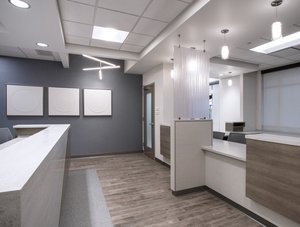Shedding Some Light: The Importance of Decorative Lighting
Entered By: Tess Salmon, NCIDQ
October 2022
It's no secret that lighting can have a huge impact on a space and the business that occupies that space. We’ve all likely experienced this firsthand, whether or not we realize it in the moment. For instance, an upscale restaurant that feels too bright may leave you not wanting to return, while a more dimly lit and inviting dining space could have you coming back frequently and telling everyone you know about it. The same can be true for commercial offices and healthcare spaces – lighting can make or break the experiences of visitors, patients, and employees. In fact, good lighting has been proven to improve mood, boost creativity, and increase employee productivity. So, if lighting has such a big impact, what do designers need to consider to ensure that the decorative lighting they select is leaving a positive impression?
There are a few key items to be evaluated when selecting decorative lighting: application and function, scale and form, and of course, style! First, we can evaluate the application to determine the function that needs to be met. For example, a retail space selling optical frames needs to be fairly bright, to not only highlight the products on display, but keep customers feeling awake and energized to shop around. At RMK, we incorporate lighting into custom optical display designs, and work with the Architect and Contractor on a job to ensure that a retail area will be well-lit and visually interesting. On the other hand, a waiting room should be a happy medium – if a waiting area is too bright, a nervous patient may not be able to relax. A waiting area should also not be too dim, as patients may need to see well enough to fill out paperwork, and maneuver through the space safely. A lobby or reception area can play with different levels of lighting to highlight design features, or draw attention and create a natural gravitation point towards a check-in desk. Designers can also look at fixture temperatures and types to meet functional needs. For instance, a waiting area could benefit from a warm light temperature to create a relaxing atmosphere. Different fixture types such as pendants, wall lights, and table or floor lamps can be layered to create visual interest. RMK keeps lighting design in mind from the beginning of our time on a project to ensure that we are meeting the functional needs, as well as taking opportunities to highlight features, or create a feature with the lighting itself.
Designers also look at the form of a fixture to decide if it is the right choice for a space. “Form” refers to the shape of a fixture and its position within a space. Length, height, and shape are all elements of form, and each one is an important consideration when selecting decorative lighting for a space. We can evaluate the form of a fixture to determine if it will properly fit the scale of a space. If a fixture is too small, it may look awkward or get lost in the design of a room. On the other hand, if a fixture is too large for its application, then it can overpower the space and draw attention in a negative way.
Lastly, a designer will ensure that a decorative lighting fixture complements the design style of the space. In a lobby or reception area, the lighting has to set the right tone for everyone entering the building. Good lighting design in a space like this can leave a positive first impression that is long-lasting. Adding the right types of decorative lighting can add a great deal of visual interest and truly take your design to the next level. While a space could be properly illuminated without decorative pendants, wall lights, or table lamps, it’s these additional decorative fixtures that can impact the atmosphere of a space, and drive visitors towards having a positive experience and wanting to come back.
Text Sources: Role Of Commercial Decorative Lighting In Modern Interiors (mountlighting.co.uk)
Image Sources: RMK
Coming in 2023: Dermatology Associates of Oxford
Oxford , MS
Specialty Orthopedic Group of MS
Tupelo, MS
Advanced Heart and Vein center
Thorton, CO




